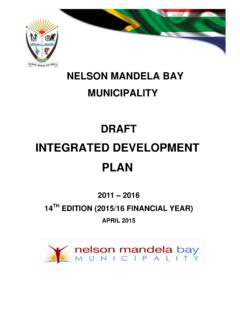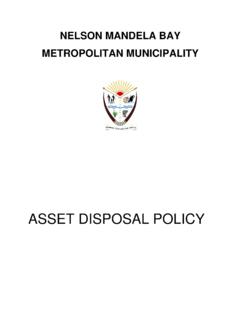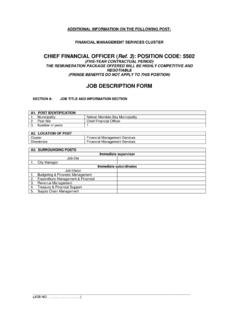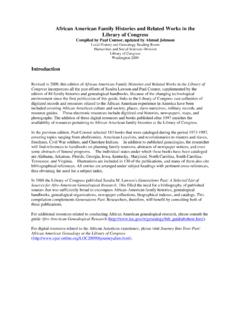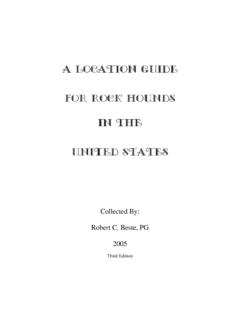Transcription of BUILT ENVIRONMENT PERFORMANCE PLAN (BEPP)
1 BUILT ENVIRONMENT . PERFORMANCE PLAN. (BEPP). 2014/15 SUBMISSION. May 2014. TABLE OF CONTENTS. 1. INTRODUCTION AND 1. INTRODUCTION .. 1. PURPOSE OF BEPP .. 1. ADOPTION OF BEPP BY COUNCIL .. 2. RELATIONSHIP OF BEPP TO OTHER STRATEGIC DOCUMENTS .. 2. REFERENCE DOCUMENTS IN PREPARING BEPP .. 3. 2. STRATEGIC REVIEW OF BUILT ENVIRONMENT .. 4. CURRENT PERFORMANCE OF BUILT ENVIRONMENT .. 4. ECONOMIC INFRASTRUCTURE REVIEW .. 15. BASIC INFRASTRUCTURE REVIEW .. 27. RESIDENTIAL INFRASTRUCTURE REVIEW .. 33. COMMUNITY INFRASTRUCTURE REVIEW .. 41. TRANSPORTATION REVIEW .. 42. SUSTAINABLE DEVELOPMENT REVIEW .. 47. IMPACT OF SECTOR REVIEWS SPATIAL FORM .. 51. 3. STRATEGIES AND PROGRAMMES .. 54. LONG-TERM VISION .. 54. SPATIAL DEVELOPMENT STRATEGY OF NMBM .. 56. AREA-BASED MANAGEMENT INITIATIVES .. 68. COORDINATION AND ALIGNMENT WITH SIPS .. 70. LAND RELEASE AND DEVELOPMENT STRATEGY AT CITY-WIDE. LEVEL .. 73. IDENTIFICATION OF URBAN NETWORK, INTEGRATION ZONES.
2 AND HUBS .. 75. 4. OUTCOMES AND OUTPUT .. 87. 5. INSTITUTIONAL AND FINANCIAL ARRANGEMENTS .. 88. INSTITUTIONAL ARRANGEMENTS FOR INTEGRATED 88. INSTITUTIONAL ARRANGEMENTS FOR CAPITAL PROGRAMME. MANAGEMENT .. 90. SUPPLY CHAIN MANAGEMENT AND PROCUREMENT PLAN .. 91. PARTNERSHIPS .. 92. VALUE OF PROGRAMMES AND PROJECTS BY SECTOR .. 92. VALUE OF PROJECTS BY INTEGRATION ZONES .. 93. VALUE OF EACH CATALYTIC PROJECT OR PROGRAMME .. 94. NON-INFRASTRUCTURE RELATED INTERVENTIONS IN. INTEGRATION ZONES .. 94. APPLICATION OF GRANT ALLOCATIONS .. 94. 6. BIBLIOGRAPHY .. 96. LIST OF ANNEXURES. ANNEXURE A PERFORMANCE Matrix ANNEXURE B Overview of Economy ANNEXURE C Development Areas Map ANNEXURE D Sectoral Provision Analysis Plans ANNEXURE E Project Level Data (MBDA Projects). LIST OF ACRONYMS. ATTP Assistance to the Poor BEPP BUILT ENVIRONMENT PERFORMANCE Plan BRT Bus Rapid Transport CBD Central Business District CDC Coega Development Corporation CETT Corporate Environmental Task Team CIDZ Coega Industrial Development Zone CITP Comprehensive Integrated Transport Plan CORPGIS Corporate Geographic Information Systems DEDEAT Department of Economic Development, Environmental Affairs and Tourism DORA Division of Revenue Act DWA Department of Water Affairs EC Eastern Cape EDRS Economic Development & Recreational Services EIA Environmental Impact Assessment EMF Environmental Management Framework EPRU Eastern Province Rugby Union GGP Gross Geographic Product GIS Geographic Information Systems GRAP 17 Generally Recognised Accounting Practices (Property, Plant and Equipment).
3 GVA Gross Value Added HDA Housing Development Agency HDMS Housing Delivery Management System HIV/AIDS Human Immunodeficiency Virus causing the Acquired Immunodeficiency Syndrome HSDG Human Settlements Development Grant ICDG Integrated City Development Grant ICLEI International Council for Local Environmental Initiatives IDP Integrated Development Plan IDZ Industrial Development Zone IHHSG Integrated Housing and Human Settlements Grant ILIS Integrated Land Information System IPTS Integrated Public Transport System IT Information Technology ITP Integrated Transport Plan LAMS Land Asset Management System LED Local Economic Development LUMS Land Use Management System MBDA Mandela Bay Development Agency MDTTT Multi-Disciplinary Technical Task Team MOSS Metropolitan Open Space System NDP National Development Plan NDPG Neighbourhood Partnership Development Gant NLLS Nooitgedacht Low Level Scheme NMBM Nelson Mandela Bay Municipality NMBM IDP Nelson Mandela Bay Municipality's Integrated Development Plan NMBMM Nelson Mandela Bay Metropolitan Municipality NMMOSS Nelson Mandela Metropolitan Open Space System NT National Treasury PDoHS Provincial Department of Human Settlements PICC Presidential Infrastructure Coordinating Commission PRASA Public Rail Authority of South Africa PTIG Public Transport Infrastructure Grant PTIS Public Transport Infrastructure and Systems PTISG Public Transport Infrastructure and Systems Grant PTNO Public Transport Network Operator PTOG Public Transport Operating Grant PTP Public Transport Plan RE Scheme Return Effluent Scheme ROD Record of Decision SCU Sustainable Community Unit SCUs Sustainable Community Units SDBIP Service Delivery and Budget Implementation Plan SIPs Strategic Infrastructure Projects SMP Sanitation Master Plan StatsSA Statistics South Africa UNS Urban Network Strategy USDG Urban Settlements Development Grant W&S Water and Sanitation
4 WMP Water Master Plan WWTW Waste Water Treatment Works 1. 1. INTRODUCTION AND BACKGROUND. INTRODUCTION. This BUILT ENVIRONMENT PERFORMANCE Plan follows the BEPP content and format as supplied by National Treasury in the Guidance Note (National Treasury, Cities Support Programme: BEPP Guidance Note for 2014/15, 2013) and should be read in conjunction with the previous year's BEPP. submission (NMBM: Office of the COO, 2013) for additional background information. PURPOSE OF BEPP. The previous annual BEPPs were submitted for the purpose of accessing the Urban Services Development Grant (USDG) from the National Department of Human Settlements and National Treasury. The USDG is a conditional grant and the BEPPs submitted, complied with the necessary requirements. The 2014/15 BEPP represents a "new era" BEPP, which attempts to align the various grant funding streams received from National Treasury. These include the Integrated City Development Grant (ICDG), the USDG, the Integrated Housing and Human Settlements Grant (IHHSG), the Social Housing Restructuring Grant, Public Transport Infrastructure Support (PTIS), and the Neighbourhood Partnership Development Grant (NPDG).
5 The BEPP aims to demonstrate the use of these grants for the purpose of spatial restructuring through targeting the expenditure in areas that will maximise the positive impact on citizens, leverage private sector investment, and support growth. A transformed spatial form and a more compact city is the ultimate aim. 2. It is shown elsewhere in this document that the NMBM is highly dependent . in fact, overdependent on the grant funding received from National Treasury. Efforts are being made to reduce the levels of dependency over time. It is to be noted that as this is the first BEPP developed since the imposition of the new BEPP requirements, the Municipality is still gearing itself up to be fully compliant in respect of the interaction between the Urban Network Strategy, BUILT ENVIRONMENT PERFORMANCE Indicator processes and budget alignment;. this will be enhanced in the 2015/16 BEPP. ADOPTION OF BEPP BY COUNCIL. A first Draft BEPP 2014/15 was submitted to National Treasury within the timeframe required, 31 January 2014.
6 Based on the document, certain comments were made by the National Treasury team; these comments have since been attended to, where possible. The initial intention was to present the BEPP to a multisectoral grouping and National Treasury on 14 April 2014. This date was subsequently postponed to 14 May 2014, and then rescheduled to a date in June 2014. The BEPP will be submitted to Council for approval prior to 30 May 2014. Thereafter, the approved document will be submitted to National Treasury. RELATIONSHIP OF BEPP TO OTHER STRATEGIC DOCUMENTS. The BEPP is to be read together with and be seen as complementary to the Municipality's key strategic documents, such as the Integrated Development Plan, the Budget, the Spatial Development Framework, the Integrated Public Transport Strategy and the Human Settlements Plan. 3. The BEPP can be seen to represent the investment strategy of the Municipality in fulfilling its objectives of equitable city development, transformed spatial realities and more compact city development.
7 REFERENCE DOCUMENTS IN PREPARING THE BEPP. The following strategic and other documents have served as reference documents in the preparation of the 2014/ 2015 BEPP: Algoa Water Reconciliation Study, 2012. ANC Election Manifesto, 2014. Budget Speech by South African Minister of Finance, 2014. BUILT ENVIRONMENT PERFORMANCE Indicators (Draft). Cities Support Programme: BUILT ENVIRONMENT PERFORMANCE Plans (BEPPs) Guidance Note, 2013. Comprehensive Integrated Transport Plan, 2011. Demographic Update for NMBM by Development Partners, 2007. Informal Settlements Upgrading Plan, 2008. Infrastructure Maintenance Backlog Assessment, 2011. National Development Plan, Vision 2030. NMBM 2013/14 Integrated Development Plan NMBM Draft Budget 2014/15. NMBM Draft Urban Network Strategy, 2014. NMBM Human Settlements Strategic Framework 2030, 2012. NMBM Integrated Development Plan 2011 - 2016, 2013. NMBM Local Government Turnaround Strategy, 2010. NMBM Metropolitan Spatial Development Framework, 2009.
8 NMBM Sanitation Master Plan, 2012. NMBM Water Master Plan, 2006. Proposed high-level Housing Strategy for Nelson Mandela Bay Municipality, December 2012 by Shisaka Development Management Services SA Census 2011, Stats SA, 2011. Sustainable Communities Planning Guide, 2007. 4. 2. STRATEGIC REVIEW OF BUILT ENVIRONMENT . CURRENT PERFORMANCE OF BUILT ENVIRONMENT . Situational analysis of Nelson Mandela Bay A situational analysis of Nelson Mandela Bay, covering various socio- economic trends, is presented below. Demographic Background (a) Current situation The following statistics are relevant: Population - 1,152,115 (Census 2011). Households (formal) - 276 850 (Census 2011). Area covered - 1 950 km . Unemployment rate - 32,34% (Global Insight, 2013). The composition of the above is detailed in Tables 1 to 3 below: TABLE 1: Demographic Information on Nelson Mandela Bay: Age Distribution 0-14 Years Old 15-65 Years Old > 65 Years Old Total 294269 795392 62453 1152114.
9 Source: Stats SA, 2011. 5. TABLE 2: Demographic Information on Nelson Mandela Bay: Household Distribution Type of household Total Formal households 276850. Informal households 30202. Households/Flats/Rooms in back- 6890. yards Informal households in back-yards 8862. Other 1488. Total 324292. Source: Stats SA, 2011. TABLE 3: Demographic Information on Nelson Mandela Bay: Employment Status Official employment Working age % of working age status population population Employed 290155 Unemployed 209088 Others (not 289969 economically active). Not applicable 6180 Labour (Total) 795392 Source: Stats SA, 2011. The population trend in Nelson Mandela Bay is reflected in the table below: 6. TABLE 4: Population Trends for Nelson Mandela Bay (2001 to 2011). Year Total Asians / Black Coloureds Whites Indians Africans (%) (%). (%) (%). 2001 1 005 804 2007 (CS) 1 050 933 2011 1 152 112 2015 1 224 630 2020 1 243 930 Sources: StatsSA (Census, 2001), StatsSA (Community Survey, StatsSA.)
10 Mid-year Estimates and StatsSA (Census, 2011). GRAPH 1: Household Income Distribution (2001). 7. GRAPH 2: Household Income Distribution (2011). Sources: Stats SA, 2011; Census 2011; Statistics South Africa The No Income', Unspecified' and Not Applicable' labels in Graph 2 include those outside the working age group of 15-65 years. Nelson Mandela Bay is the driver of the Eastern Cape economy, with 41,81%. of the provincial GGP (Global Insight, 2013). Altogether 71 794 of the total number of 276 850 formal households are classified as indigent (in terms of the indigent register of the Municipality). Altogether 44% of households receive at least one social grant. The HIV/AIDS prevalence rate is 30,8%. Approximately 3% of residents have received no schooling; 13% have passed Grade 7 or less (primary school level); while 75% have passed Grade 12 or less (secondary school level) (these figures exclude the current population of children of pre-school and school-going age, 0-19 years) (Census, 2011).

